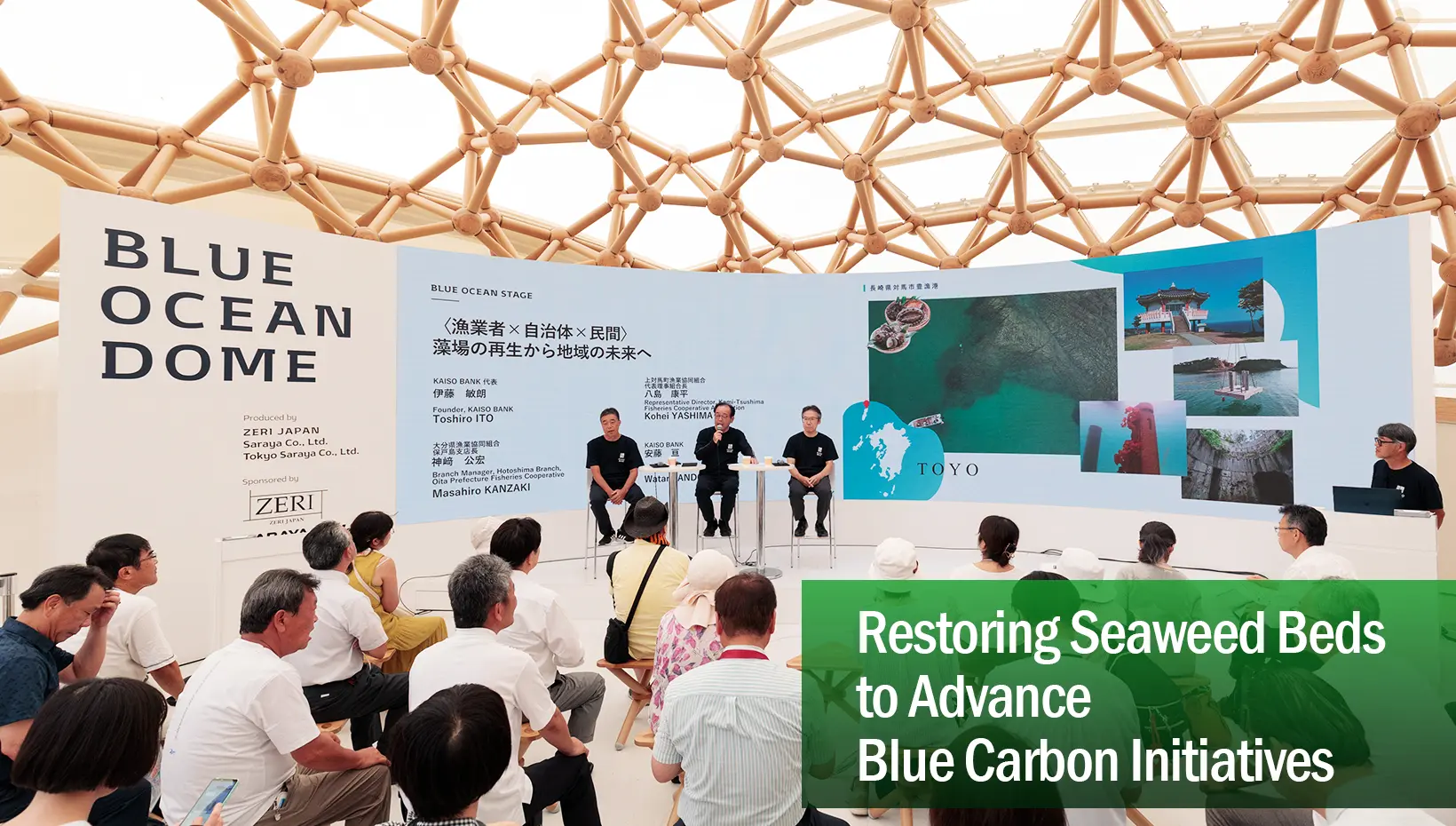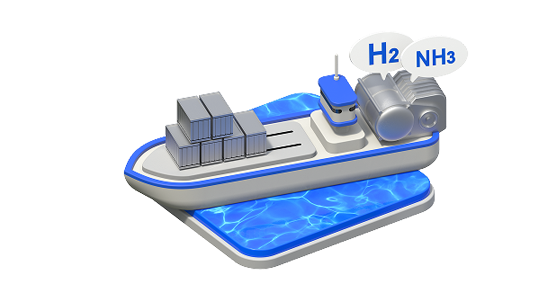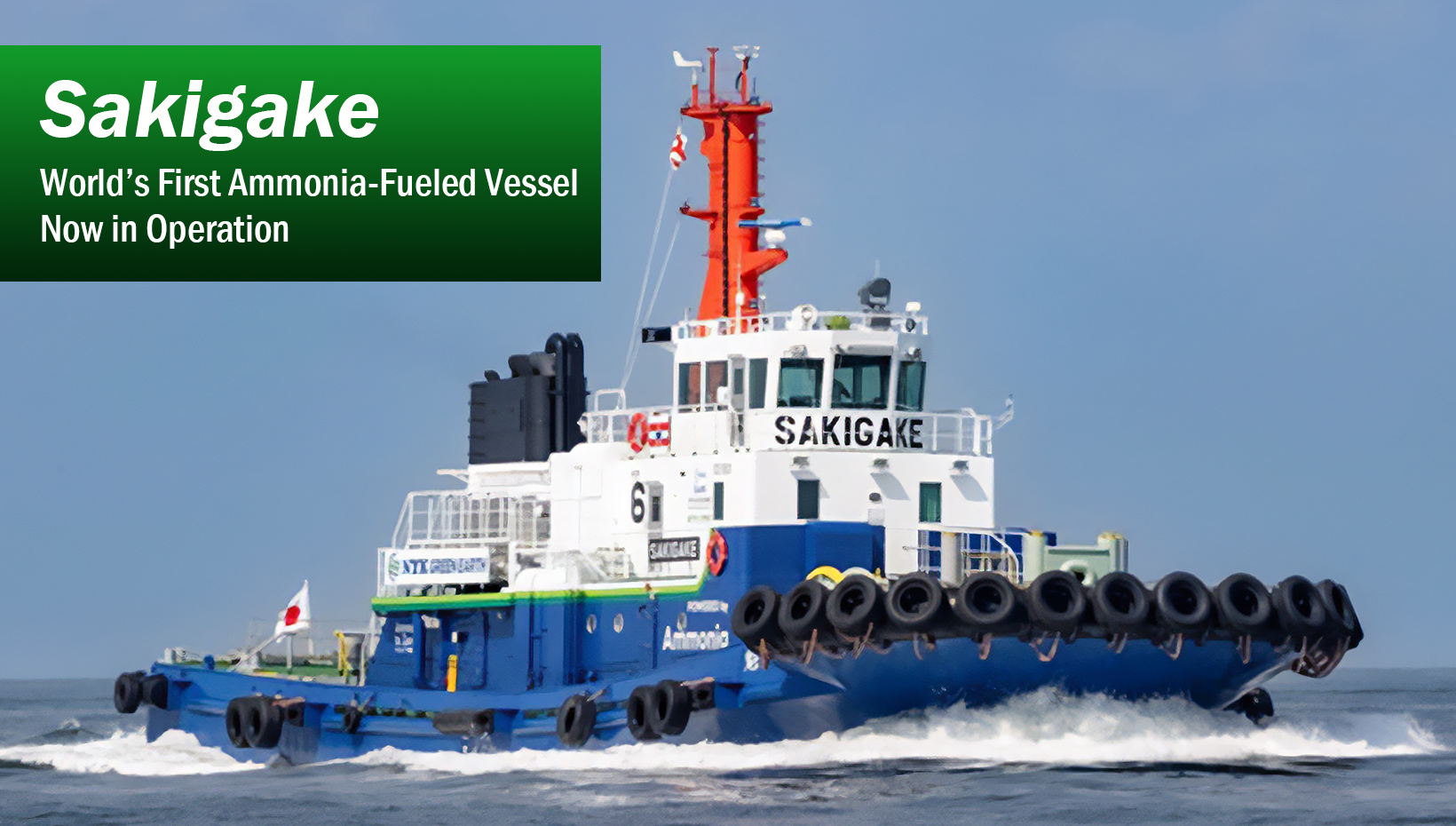
With the slogan “Saving the world through ammonia,” a commemorative ceremony was held at the Port of Yokohama on March 28, 2025, marking the successful completion of a demonstration voyage by the ammonia-fueled tugboat Sakigake (meaning “pioneer” in Japanese).
Developed under NEDO’s Green Innovation (GI) Fund Project for Next-Generation Vessels, Sakigake is an ammonia-fueled tugboat jointly designed and built by Nippon Yusen Kabushiki Kaisha (NYK) and IHI Power Systems, in collaboration with Nippon Kaiji Kyokai (ClassNK). The vessel was completed on August 23, 2024, and following a three-month demonstration voyage, has now commenced commercial operations. It will operate in Tokyo Bay, contributing to the accumulation of practical knowledge and operational expertise in the use of ammonia as a marine fuel. At the recent ceremony, both the vessel and the results of the demonstration project were formally presented to the public.
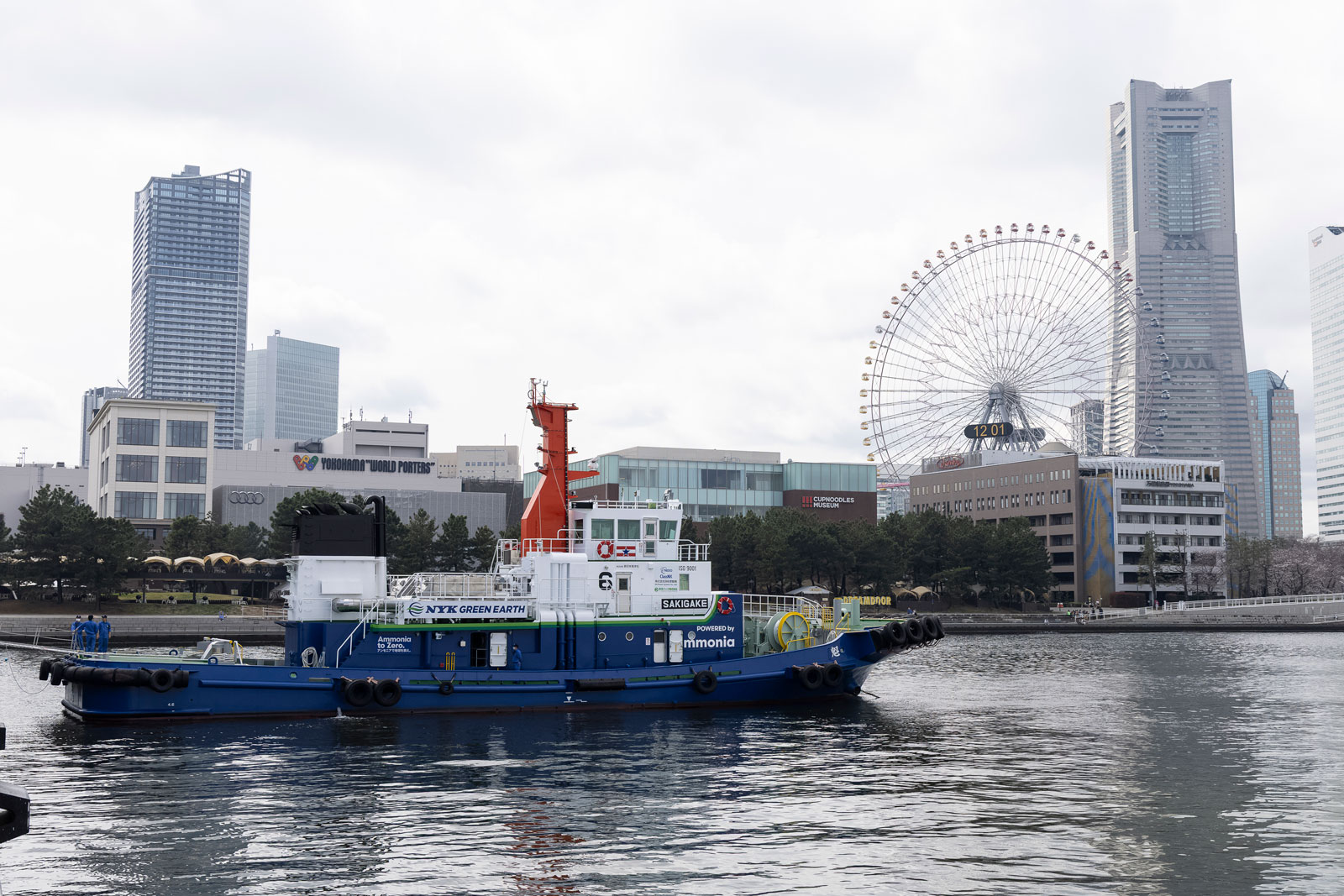 The ammonia-fueled tugboat Sakigake
The ammonia-fueled tugboat SakigakeAt the ceremony, former Prime Minister Yoshihide Suga (the 99th Prime Minister of Japan and current member of the House of Representatives) delivered a speech, stating:
“During my term as Prime Minister, I established the ¥2 trillion Green Innovation (GI) Fund, and I am truly pleased that one of its earliest tangible results is the successful launch of the world’s first ammonia-fueled vessel.”
He emphasized the significance of the GI Fund in delivering concrete results.
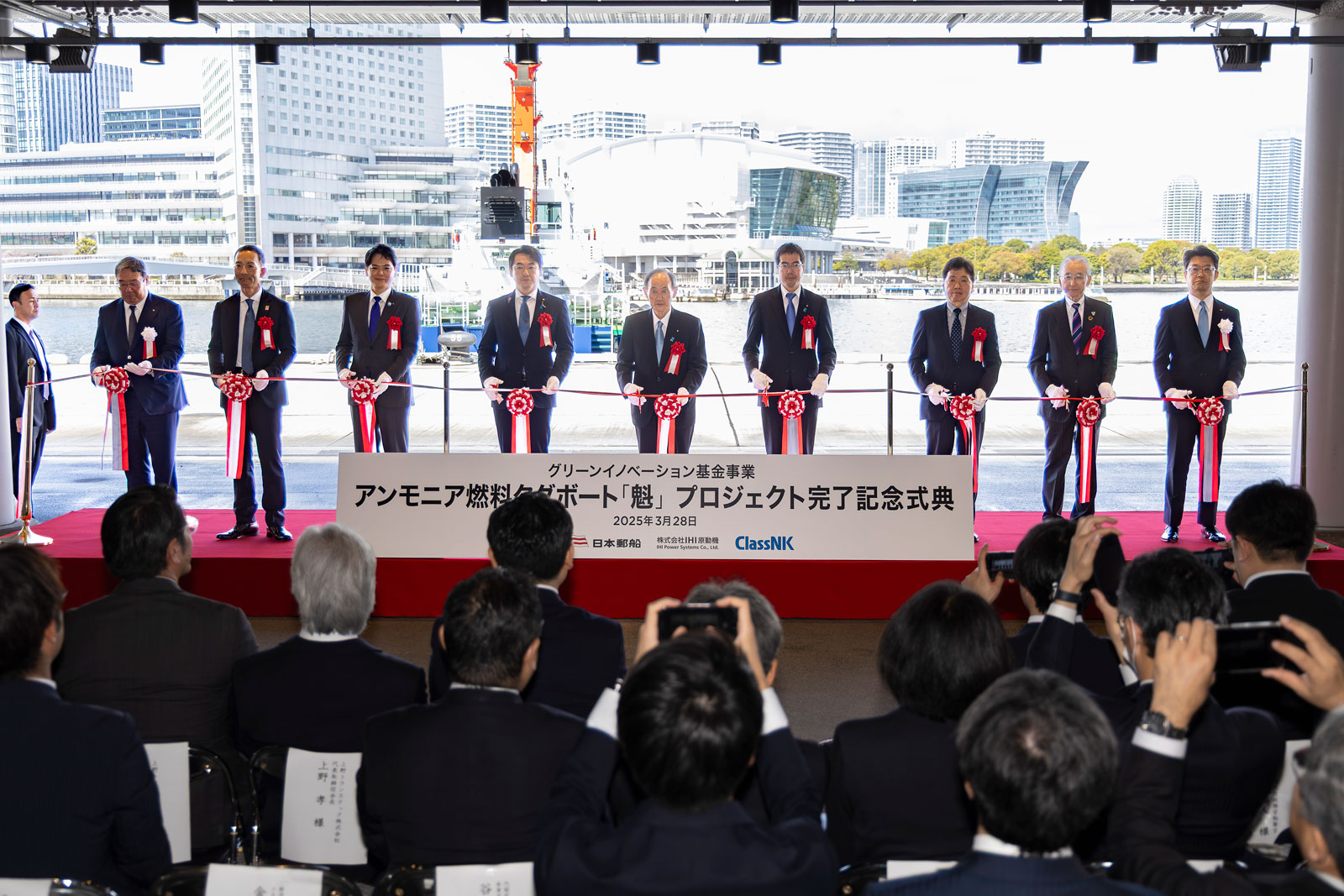
Scene from the commemorative ceremony, attended by representatives from NYK, IHI Power Systems, ClassNK, and NEDO, along with former Prime Minister Yoshihide Suga, Yokohama Mayor Takeharu Yamanaka, and officials from the Ministry of Economy, Trade and Industry (METI) and the Ministry of Land, Infrastructure, Transport and Tourism (MLIT).
GHG Emissions Reduced by Over 90%
In this project, a three-month demonstration voyage was conducted in Tokyo Bay by Shin-Nippon Kaiyosha, a member of the NYK Group, while performing actual towing operations. According to Takaya Soga, President of NYK, “The vessel achieved over 90% for both the ammonia co-firing ratio and the reduction rate of GHG emissions, demonstrating that ammonia is a viable marine fuel.” Under full engine load conditions (100% load factor), it also demonstrated a maximum GHG emission reduction of approximately 95%.
Although ammonia does not emit CO₂ when burned, it is more difficult to ignite compared to conventional heavy fuel oil. As a result, co-firing with heavy fuel oil is required when injecting fuel into the engine. A key technical challenge is how much the ammonia co-firing ratio can be increased.
At a press conference following the ceremony, NYK President Takaya Soga remarked, “We exceeded expectations and successfully achieved a high co-firing ratio of approximately 95%.”
One of the most significant achievements of this project was that Japan became the first country in the world to develop a dual-fuel (DF) engine capable of operating on both ammonia and heavy fuel oil. Sakigake was originally equipped with a DF engine using liquefied natural gas (LNG) and heavy fuel oil, but it has now been retrofitted with a new DF engine that runs on ammonia and heavy fuel oil, marking its transformation into an ammonia-fueled vessel.
Another key aspect of the project was the implementation of a dedicated vessel design and onboard safety systems to protect crew members from ammonia toxicity, along with appropriate training programs for the crew.
Although the amount of nitrous oxide (N2O) — a byproduct of ammonia combustion — was lower than expected, a catalytic reduction system was also developed to neutralize any N2O emissions, and this technology has been incorporated into Sakigake.
(The accompanying video describes the vessel as a “commercial ship powered by ammonia.”)
Setting International Standards for Ammonia-Fueled Ships
One of the key international challenges is the lack of established regulations for ammonia-fueled vessels. As a third-party organization involved in the project, ClassNK evaluated the safety of ammonia-fueled vessels, confirming that they provide a level of safety equivalent to that of conventional oil-fueled ships.
ClassNK also supported the process of obtaining approval for alternative design from the Maritime Bureau of Japan’s Ministry of Land, Infrastructure, Transport and Tourism (MLIT), the relevant regulatory authority.
Furthermore, ClassNK incorporated the results of this demonstration voyage into its safety guidelines for ammonia-fueled vessel, originally published in August 2021, which have since been revised and updated through the third edition.
An especially noteworthy aspect of this project is its contribution to the early development of international interim guidelines for ammonia-fueled vessel.
Hayato Suga, President & CEO of ClassNK, stated:
“The safety requirements developed through this project were submitted to the International Maritime Organization (IMO) as the world’s first proposal of its kind, presented by Japan via MLIT. As a result, interim guidelines for ships using ammonia as fuel were adopted at the IMO meeting held in December 2024. Going forward, we aim to contribute to future updates of these guidelines by applying the knowledge gained through this demonstration voyage.”
Japan is expected to continue leading the international standardization of ammonia-fueled vessels.
Given the toxic nature of ammonia, further safety measures are essential. President & CEO Suga noted, “Operational safety management will become even more important in the future, and we intend to place greater emphasis on this area going forward.”
Ammonia Carrier to Launch in November 2026
Following the successful launch of the ammonia-fueled tugboat, the next development target is the application of this technology to an ammonia carrier. Development is currently underway with the aim of commencing operations in November 2026.
In July 2024, the ammonia-fueled tugboat Sakigake became the world’s first vessel to adopt the Truck-to-Ship method of bunkering using tank lorries as the supply source.
Looking ahead, research and development efforts will focus on ammonia-fueled ammonia carriers, while also working toward the establishment of a full ammonia value chain.
Takashi Murasumi, President of IHI Power Systems (as of March 2025, when the commemorative ceremony was held), explained, “We are currently conducting land-based tests at our Ota plant in Gunma Prefecture to develop an engine for an ammonia-fueled ammonia carrier. This effort builds on the know-how we gained through the development of the tugboat engine.”
The planned ammonia-fueled ammonia carrier will be a medium-sized vessel. A consortium consisting of NYK, IHI Power Systems, Japan Marine United, Japan Engine Corporation, and ClassNK is leading the development.
Pioneering Zero-Emission Vessels for Maritime Decarbonization
Akiko Iimura, Ph.D., Executive Director of NEDO, emphasized the significance of the project, stating:
“The completion and unveiling of Sakigake, the world’s first ammonia-fueled vessel, represents one of the most visible achievements among the 20 projects supported by the Green Innovation Fund. It truly lives up to its name, meaning ‘pioneer’ in Japanese.”
She went on to highlight the importance of developing next-generation vessels as a key initiative for decarbonizing the maritime industry.
“Maritime transport accounts for approximately 2% of global CO₂ emissions. As demand for shipping is expected to continue increasing, we believe that the development of next-generation zero-emission vessels powered by fuels such as ammonia and hydrogen will be essential to achieving net-zero GHG emissions by around 2050, in line with the reduction strategy established by IMO.”
In addition to ammonia-fueled vessels, steady progress is also being made in the development of hydrogen-fueled engines under the next-generation vessels project.
Chiharu Kawakita, Ph.D., Deputy Director General of Hydrogen and Ammonia Department and Project Manager of GI Fund Project (Next-generation Ship Development) at NEDO, explained:
“Development of hydrogen-fueled engines is moving forward rapidly. A land-based testing facility for full-scale hydrogen engines is currently under construction at the factory of Japan Engine Corporation and will begin operations in fiscal year 2025. There, we will conduct tests on three types of engines developed by Kawasaki Heavy Industries, Yanmar Power Technology, and Japan Engine Corporation. Following approximately one year of operational testing, these engines are expected to be installed on transport vessels and other ships starting in 2026.”
NEDO will continue to promote the research and development of next-generation fuel-powered vessels and contribute to achieving carbon neutrality in the maritime industry.
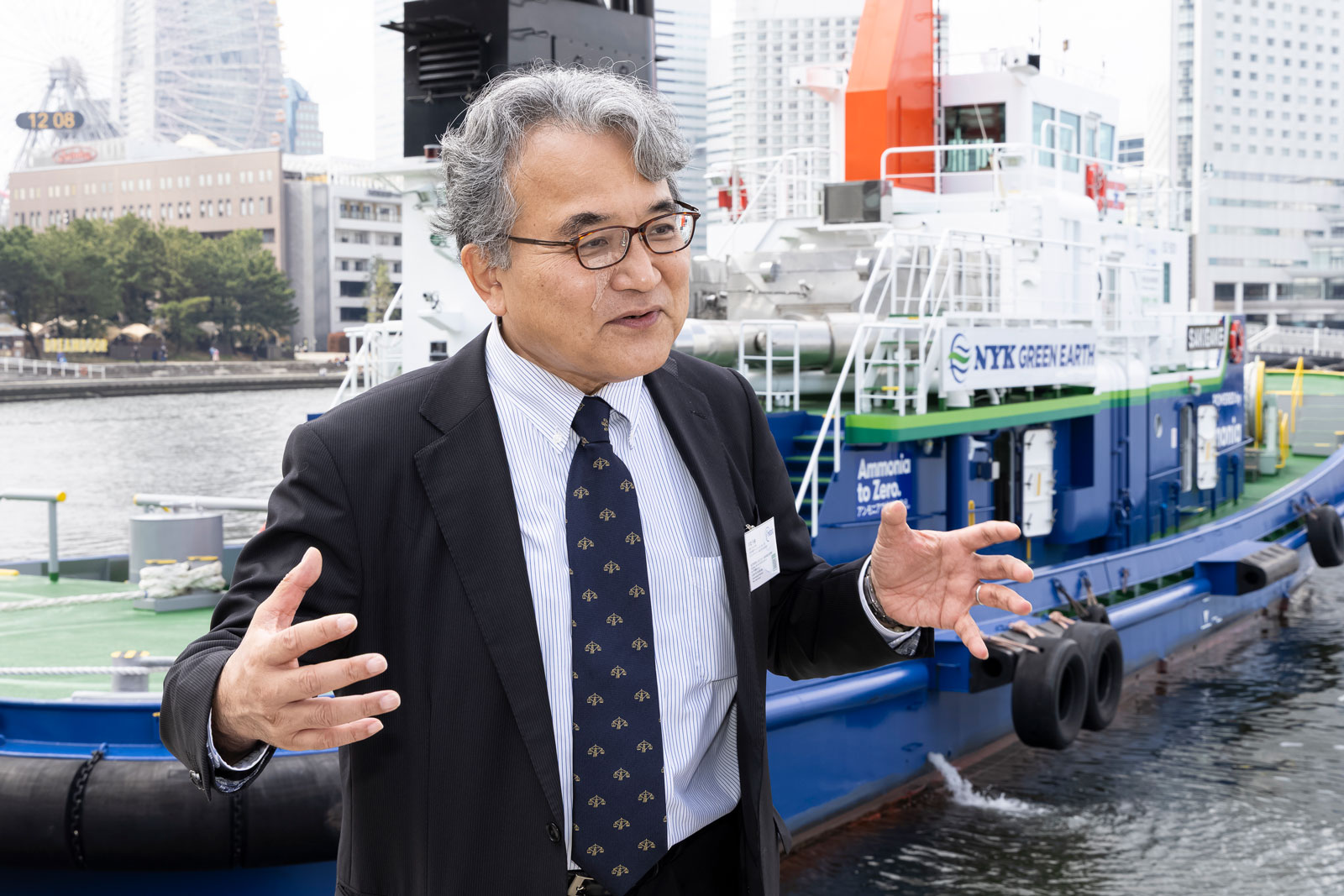
Chiharu Kawakita, Ph.D., Deputy Director General of Hydrogen and Ammonia Department and Project Manager of GI Fund Project ( Next-generation Ship Development) at NEDO

Members from NYK and IHI Power Systems working on the next-generation vessel development project



